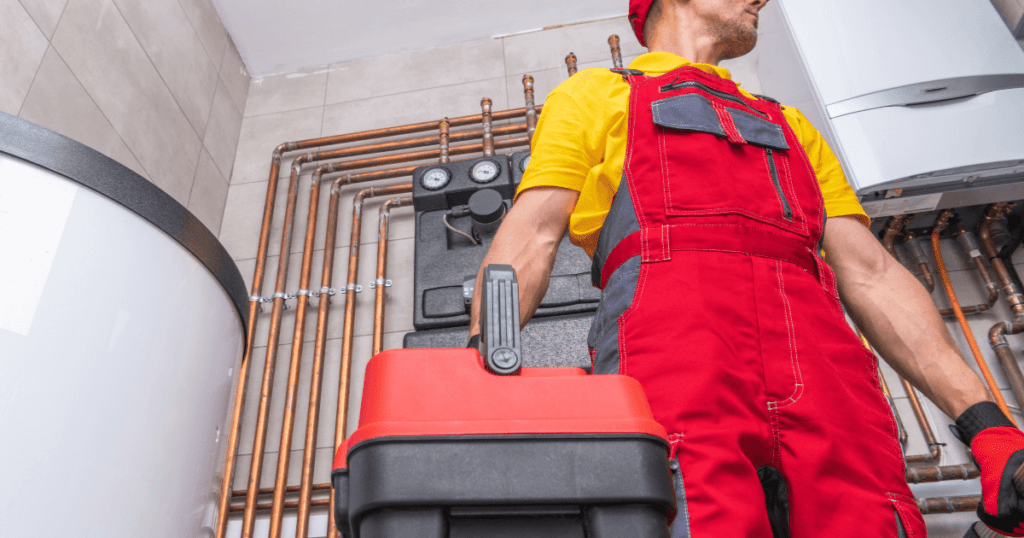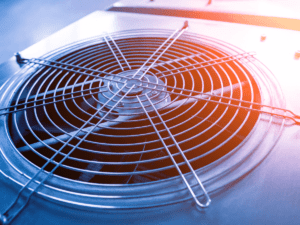A split HVAC system has both the abilities of heating and cooling and has its own indoor and outdoor units and is interlinked with each other by a cooper line.
The outdoor unit is where you’ll find the compressor and condenser. These bad boys work their magic to cool or heat the air. On the other hand, inside your home, the indoor unit holds the evaporator coil and air handling unit.
The evaporator coil does its thing to cool or heat the air, while the air handling unit takes that conditioned air and spreads it through the ductwork in your house
Unlike packaged HVAC units that contain all components in a single unit, split systems offer flexibility.
They can include different types of systems such as heat pumps and air conditioning systems.
For larger homes, multiple units may be required to ensure sufficient cooling.
Split systems can be paired with either a gas furnace or a fan coil that is installed indoors.

Types of HVAC Split Systems
Heat Pumps:
Heat pumps use electricity to extract heat from the outside, even in cold temperatures, and bring it indoors.
The outdoor unit includes a heat exchanger and compressor, while the indoor unit comprises an air handler and fan that flows air throughout the house.
Air Conditioners:
Split-system air conditioners are made up of two parts. First, you got the outdoor unit. That’s where you’ll find the compressor and condenser, doing their thing to cool or heat the air.
Then, you got the indoor unit. It comes with a furnace, evaporator, filters, and an air handler. Basically, it’s got all the stuff to make sure the air is just right for you.
Furnaces:
Furnaces are internal units that combust fuels, like gas or propane, to raise the temperature of the air, which is then disseminated via ductwork throughout your home.
Fan Coils:
Fan coils are indoor units that propel air over the coil, regulate its temperature depending on the weather, and then distribute it through ductwork in your home.
Ductless vs Ducted Systems

Split HVAC systems can either be ducted or ductless.
Ducted units use a network of ducts to distribute air throughout a building. It consists of two units, one indoors and the other outdoors.
The indoor unit houses the evaporator and the air handler while the outdoor one contains a compressor.
The air is cooled in the evaporator and then distributed throughout the building via ductwork.
Ductless unit on the flip side does not require ductwork to distribute air.
This unit comprises of multiple units. One small outdoor unit and one or more indoor units to cool or heat specific rooms or areas of a small building.
Ducted split systems serve larger buildings for central air conditioning. Ductless systems suit smaller spaces or where ducts are impractical.
Benefits of Using a Split HVAC System

Split HVAC systems have multiple benefits over HVAC units.
It is essential to keep in mind that different types of homes, flats, etc. can benefit from different types of HVAC systems units.
So one HVAC system might be the best option for one home, but it may not be for another.
Efficiency:
HVAC split systems have a range of energy efficiency levels.
Starting from the minimum efficiency range by the Department of Energy to highly efficient systems with ratings up to 24 SEER2.
Opt for Energy Star-certified split systems for superior energy efficiency compared to those meeting only DOE standards.
Choosing a more energy-efficient unit can save you some bucks on your electricity bills, especially when you can’t afford costly heating and cooling expenses.
Customization:
HVAC split systems deliver greater customization in the setup of the system because of offering you two separate parts.
Drawbacks of Using Split HVAC Systems
Installation Cost:
The first disadvantage you’ll face is paying more for the installation of the split HAVC system as compared to a packed HVAC unit because you have two install two separate units for your split HVAC system.
It can even tend to cost you more if the units have to be installed further apart from each other, for any required need of the installation process.
Even though you can be charged more because the installation varies differently for different split HVAC systems.
And if you wanted to have a ductless system to reduce installation cost then the ductless systems will cost you more as compared to the split HVAC systems.
Noise from Outdoor Unit:
If the outdoor unit is not maintained and is malfunctioning it can cause a lot of uncomfortable noises which can cause you distress.
The Outdoor Unit takes up a lot of Space:
The outdoor unit with your split HVAC system needs a lot of space or takes a lot of space and if you have a small yard or balcony. It is an intimidating task to install it properly.
Conclusion
In conclusion, a split HVAC system is a type of heating and cooling system that is split into two parts:
The indoor and the outdoor unit. The indoor unit contains the evaporator coil and the blower which work together to circulate cool or warm air throughout your home.
The outdoor unit contains compressor and the condenser coil, which work together to release heat from your home in the summer.
It absorbs heat from the outside in winters. By opting for a split HVAC system you can stay comfortable all year round!






